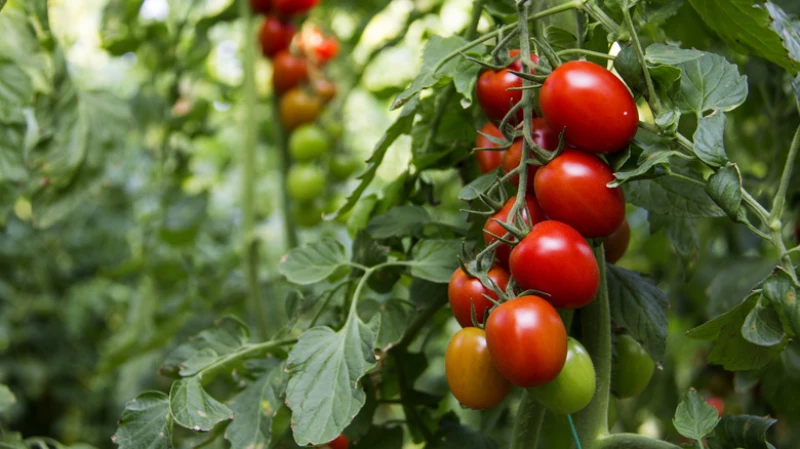Tomato plants are often targeted by a variety of pests that enjoy feasting on the fruit and leaves. While larger animals like deer, skunks, raccoons, and coyotes can be deterred with fences, there are smaller pests that pose a threat to your tomato plants.
1. Aphids
Aphids are one of the common pests that attack tomato plants. These tiny insects feed on the sap of the plant, causing stunted growth and deformed leaves. They can also transmit diseases to the plant. To control aphids, you can try using insecticidal soap or introducing natural predators like ladybugs.
1. Aphids
There are various kinds of aphids, and plenty of them like to eat the tomatoes they come across in gardens. Although these rather annoying critters are relatively tiny, they can still cause a lot of damage to your plants when they invade your yard in large numbers. Although they don't tend to consume entire plants, they definitely harm them and also leave them to be attacked by other pests and diseases. Fortunately, other creatures consume aphids, which can help keep them off of your tomatoes.
2. Armyworms
If there's something eating your tomatoes, then you may want to keep an eye out for gray or black larvae that can be identified by the cream or yellow-colored stripes on their bodies. These happen to be armyworms, and they adore tomatoes that have already ripened or even overripened. To see if this is what's been eating away at your plants, check the leaves on your tomatoes. If you can get on top of the problem early, then it will be much easier to manage.
3. Blister beetles
Blister beetles certainly don't sound like a critter that you want wandering around your garden, and that's pretty darn accurate. Another pest that will gladly eat your tomatoes, they also release a substance known as cantharidin that can cause blisters on humans. Protect both yourself and your tomatoes from this nasty critter by using row covers over your plants. If you do spot blister beetles — which are black, gray, or red — then be sure to wear gloves when quickly and carefully removing them from your garden.
4. Cutworms
Cutworms are another pest that can cause damage to your tomatoes. They are known for cutting down young plants at the soil level, causing them to wilt and die. To prevent cutworms from attacking your tomatoes, you can create a physical barrier around the base of the plants, such as a collar made from cardboard or aluminum foil. This will prevent the cutworms from reaching the stems of the plants and causing damage.
Tomato plants are vulnerable to various pests that can cause damage and hinder their growth. Here are some common pests that you may encounter:
1. Cutworms
Although cutworms don't typically target the fruit of tomato plants, they can cause damage to the stems, roots, and seedlings. This can prevent the plant from absorbing water and eventually lead to its death. Cutworms are around 2 inches long and can be black, brown, pink, or green. If you notice plants in your garden suddenly suffering, it may be a sign of cutworms in the soil. Remove them as soon as you spot them and protect vulnerable seedlings with barriers made of aluminum foil or cardboard.
2. Flea beetles
Flea beetles are small beetles that resemble fleas in appearance. They are black or brown and have white or yellow stripes on their bodies. These pests can attack germinating tomato seeds and transmit diseases to your plants. To deal with flea beetles, you can use row covers and traps with sticky surfaces to capture them. Turning the soil can also help to disturb any beetles that have settled underground.
3. Hornworms
Hornworms are caterpillars that feed on plants in the nightshade family, including tomatoes. These pests are light green in color, making them difficult to spot on tomato leaves. One way to find them is by shining a blacklight on your garden at night, which can illuminate the hornworms. Once located, you can manually remove them from the plants and dispose of them.
4. Silverleaf whiteflies
Silverleaf whiteflies are another common pest that can affect tomato plants. These tiny insects have white wings and feed on the sap of the plants, causing damage and reducing their overall health. To control silverleaf whiteflies, you can use sticky traps or insecticidal soap. It's also important to regularly monitor your plants for signs of infestation and take appropriate action.
Tomato fruit worms can be a major problem for your tomato plants. These worms feed on the fruits, causing damage and making them unsuitable for consumption. You can identify the presence of tomato fruit worms by noticing holes or tunnels in the fruits. To prevent infestation, it is important to regularly inspect your plants and remove any affected fruits. Additionally, you can use organic insecticides or biological control methods to manage the population of these worms.
Tomato Fruit Worms and How to Get Rid of Them
Tomato fruit worms can cause significant damage to the unripened fruits of your tomato plants. They have the ability to burrow deep into the stems, buds, and fruits themselves. If you come across a yellowish unripened tomato while the rest of the fruits on the vine are still green, there is a possibility of a tomato fruit worm infestation.
To effectively eliminate these pests, a mixture of water and Bacillus thuringiensis or Bt can be used. This microbial pesticide can be sprayed onto the plants to kill the host worms, preventing further infestation.








